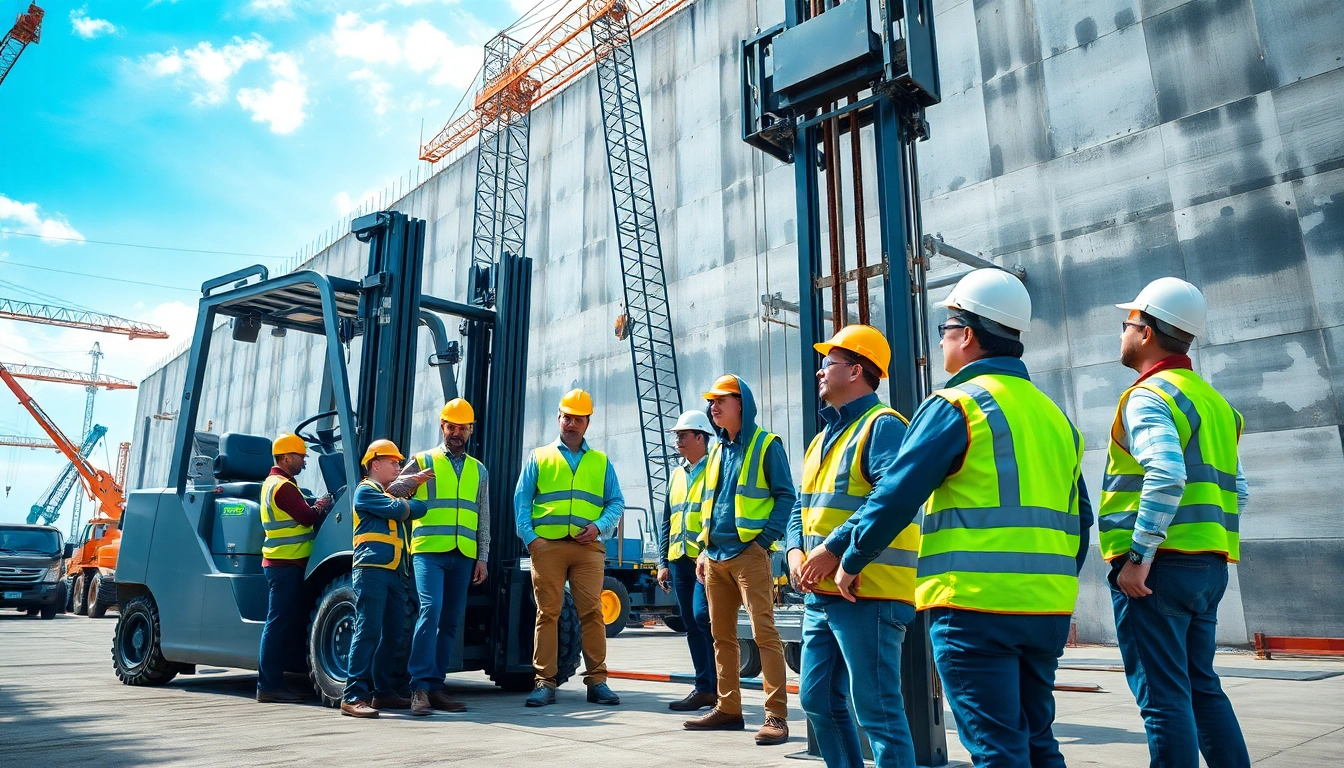Understanding the Level 5 Lifting Operations Qualification
What is the Level 5 NVQ Diploma?
The Level 5 NVQ Diploma in Controlling Lifting Operations is a nationally recognized qualification designed for individuals who oversee and manage the execution of lifting operations in a variety of environments, primarily within the construction sector. This diploma equips professionals with a comprehensive understanding of the necessary legislation, health and safety protocols, risk assessment procedures, and operational standards required for safe lifting practices.
This qualification not only demonstrates competency in handling lifting operations but also underscores the importance of effective management and communication skills required to coordinate safety among teams. As the lifting operations industry evolves, so do the challenges and techniques associated with safely overseeing these activities.
Key Learning Outcomes and Skills Developed
Completing the Level 5 NVQ Diploma enhances a range of competencies that are essential for professionals in lifting operations. Key outcomes include:
- Understanding of Legislation and Standards: Knowledge of regulations like LOLER (Lifting Operations and Lifting Equipment Regulations) and how they apply to specific lifting operations.
- Risk Assessment and Management: The ability to conduct detailed risk assessments and implement measures to mitigate hazards associated with lifting activities.
- Effective Communication: Skills in communicating with team members and stakeholders to ensure that safety protocols are understood and adhered to.
- Planning and Coordination: The capacity to plan lifting operations effectively, considering equipment, load specifications, and environmental factors.
- Problem-Solving Skills: Ability to identify potential issues during lifting operations and devise effective solutions to adapt to changing conditions.
Overview of the Qualification Structure
The Level 5 NVQ Diploma typically consists of several mandatory units that cover various aspects of lifting operations. These units may include topics on:
- Lifting methods and planning.
- Training for lifting operation crew members.
- Legal requirements and compliance.
- Equipment management and inspection standards.
Assessment is generally carried out through workplace projects, observations, and professional discussions, where candidates must showcase their ability to manage live operations and provide concrete examples of their experiences.
Common Challenges in Lifting Operations
Identifying Potential Risks and Hazards
One of the most critical roles of a lifting supervisor is identifying potential risks and hazards before commencing operations. Common risks include:
- Environmental factors such as wind or uneven surfaces.
- Equipment failure or malfunction due to poor maintenance.
- Human error from lack of training or communication breakdowns.
- Improper load handling that could lead to accidents or injuries.
Recognizing these threats early is crucial for establishing a safe working environment and averting accidents.
How to Mitigate Safety Issues
Mitigation strategies are essential for enhancing safety during lifting operations. Effective techniques include:
- Regular Training and Certification: Ensuring all crew members are well-trained and regularly recertified on equipment and safety procedures.
- Daily Equipment Inspections: Implementing a routine check of all lifting equipment to ensure functionality and compliance with safety regulations.
- Thorough Risk Assessments: Conducting detailed risk assessments prior to operations and modifying plans based on findings.
- Clear Communication Protocols: Establishing firm lines of communication for all team members to enhance awareness of their roles and responsibilities.
Real-world Examples of Lifting Failures
Learning from real-world accidents can provide valuable insights into the significance of safety and compliance in lifting operations. Notable incidents include:
- A construction site where a crane collapsed due to improper load calculations, leading to severe injuries and financial liabilities.
- A situation where workers were injured because of failure to secure a safety harness while operating a boom lift in high winds.
- Accidents resulting from unexpected obstructions in the area where lifting operations were carried out, demonstrating the need for thorough site assessments.
These examples underscore the catastrophic consequences of neglecting safety protocols and the importance of training and preparation.
Best Practices for Level 5 Lifting Operations
Effective Planning and Preparation
Effective planning is the foundation of safe and successful lifting operations. Integral components of planning include:
- Load Analysis: Evaluating the load specifications, including weight, dimensions, and center of gravity to determine appropriate lifting equipment.
- Site Assessment: Carrying out a thorough inspection of the site to identify potential hazards, obstructions, and environmental challenges.
- Resource Allocation: Ensuring that the right equipment and personnel are available and adequately trained to perform the operation safely.
Utilizing effective project management software can further streamline planning efforts and improve communication among team members.
Utilizing Equipment Safely and Efficiently
Proper utilization of lifting equipment is vital for maintaining safety standards. Key considerations include:
- Manufacturer Guidelines: Adhering strictly to the manufacturer’s instructions and safety guidelines for each piece of equipment.
- Training and Familiarization: Ensuring that operators are not only qualified but also familiar with the specific equipment being used for the lift.
- Regular Maintenance: Establishing a maintenance schedule to check for wear and tear on lifting equipment, ensuring it operates at peak efficiency.
Creating a Culture of Safety Among Workers
Creating a safety culture is essential for preventing workplace accidents and ensuring compliance with health and safety standards. Strategies include:
- Safety Meetings: Regularly scheduled meetings to discuss safety protocols and encourage the team to share any potential concerns.
- Recognition Programs: Implementing programs to reward safe practices among team members can motivate compliance and enhance safety awareness.
- Open Communication: Encouraging workers to voice safety concerns without fear of reprisal empowers them to take part in their own safety.
Strategies for Answering NVQ Exam Questions
Breaking Down Exam Formats and Requirements
Understanding the structure of the NVQ assessments is crucial for success. The exams are typically divided into theoretical and practical components, requiring candidates to:
- Understand Key Terminology: Familiarizing oneself with the common terms and phrases used in lifting operations.
- Practice Scenario Questions: Engaging in practice scenarios to develop the ability to apply theoretical knowledge to real-world situations.
- Review Past Papers: Analyzing past exam questions to identify recurring themes and areas of focus.
Tips for Crafting Compelling Answers
When answering NVQ questions, clarity and conciseness are critical. Useful strategies include:
- Start with Clear Definitions: Begin answers by defining key terms or concepts relevant to the question.
- Use Examples: Support arguments with specific examples from personal experience or observed operations.
- Stay Relevant: Ensure responses address the question directly, avoiding unnecessary information.
Utilizing Provided Resources and Study Materials
Resources are invaluable for exam preparation. Candidates are encouraged to leverage available study materials, which may include:
- Textbooks and Guidelines: Recommended industry texts that cover essential knowledge and practice.
- Online Courses: Utilizing e-learning platforms that offer NVQ-related courses to reinforce understanding.
- Mentorship Opportunities: Seeking mentorship from experienced lifting supervisors can provide practical insights and tips.
Tracking Performance and Improvement
Measuring Success in Level 5 Lifting Operations
To ensure the effectiveness of lifting operations, key performance indicators (KPIs) should be established, targeting areas like:
- Number of incidents or accidents reported during operations.
- Feedback from team members regarding safety practices.
- Operational efficiency and adherence to timelines.
Employing these metrics can help organizations refine their lifting operation strategies and improve overall safety performance.
Continuous Professional Development Opportunities
Engaging in continuous professional development (CPD) is critical for professionals in lifting operations. Opportunities include:
- Workshops and Seminars: Participating in industry workshops that focus on latest safety technologies and practices.
- Certification Programs: Enrolling in advanced certification programs that broaden knowledge beyond the Level 5 NVQ.
- Networking Events: Attending industry networking events to stay connected with advancements and trends in the lifting operations sector.
Evaluating the Effectiveness of Training Programs
Regular evaluation of training programs is imperative for ensuring relevance and effectiveness. Metrics to consider include:
- Post-training assessments to measure knowledge retention and understanding.
- Feedback from attendees to identify areas for improvement.
- Tracking the application of learned skills in the workplace to ensure continued compliance with safety standards.
In summary, achieving the Level 5 lifting operations answers involves understanding the qualification, addressing common challenges, applying best practices, and strategically preparing for assessments. Continuous improvement and adherence to safety protocols not only enhance personal competency but also contribute significantly to the overall safety culture within the lifting operations industry.








